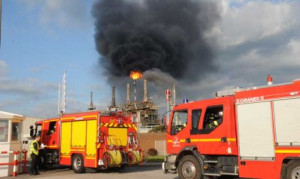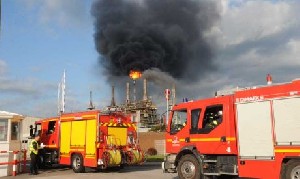At a petrochemical plant, a pipe supplying air to a steam production boiler exploded at 3:40 pm, triggering a few seconds later a 2nd and more powerful explosion on a duct used to recover volatile organic compounds (VOC). The explosion and debris from the duct caused a fire outbreak on both a duct cyclofilter and a 1,000-litre vinyl acetate tank at the base of a distillation column, as well as a leak on the pipe feeding a 1-m³ oxygen tank. The safety controller immediately shut down the boilers, and site facilities were switched into safe mode by the operator from the control room. This service shutdown redirected output to the flare; a flame and thick plume of black smoke were visible from afar since the steam release was not available. The internal emergency plan was activated at 3:47 pm; the plant’s siren sounded and the 250 employees were evacuated, as were personnel from neighbouring firms. Onsite first responders extinguished the fire sources using 2 foam nozzles and 4 vehicles; they left the oxygen tank empty, but set up nozzles and a water curtain to dilute the leak. The situation was brought under control by 4:15 pm, and the emergency plan was lifted at 6:42 that evening. Rescue services, notified ahead of time, transported to hospital 5 employees, 2 of whom with hearing problems and the other 3 suffering from shock due to the blast; 1 subcontractor was examined at the site’s infirmary. The VOC duct was destroyed over some 100 m. The boilers were damaged; the cracking furnaces had to be inspected, with their heating tubes needing to be changed due to the sudden shutdown without steam. The site was reopened 2 months later and repairs were fully completed after 6 months. The damage and extended downtime generated economic losses on the order of several million €, not counting the redundancies caused by plant renovations.
The polyethylene (PE) polymerisation unit had been modified 2 years prior to the accident; moreover, a system for treating the VOC stemming from degassing of this unit (cooling and condensation of the heaviest compounds) had been installed. The compounds remaining in a gaseous state (ethylene, vinyl acetate) were then piped to a fan, with a flow rate of 25 to 50 kg/hr. At the fan outlet, these compounds entered a VOC recovery duct (L: 300 m, d: 1.5 m). Initially, this duct solely transported a mix composed of air and a small proportion of degassed VOC from the PE bead storage silos (< 10% of the lower flammable limit). The site's 2 boilers, which were supplying steam to both the site's steam cracker and flare in order to remove black smoke, burned the gaseous mix being fed through the duct. This process enabled eliminating a large portion of the VOC generated by the polyethylene production process.
The investigation conducted by the operator revealed that a liquid hydrocarbon mix (solvent and vinyl acetate) had formed inside the polymerisation VOC recovery pipe before being propelled by the fan into the boiler supply duct, where this mix accumulated. An inflammable atmosphere had thus been created in the pipe section adjacent to the boilers. On the day of the accident, this atmosphere caused an explosion in the air inlet to one of the boilers; this blast spread to the duct section near the fan. Such a scenario of driving liquid VOC at the degassing outlet of extruding machines had not been anticipated in the safety reports prior to modifying the polymerisation unit.
The operator proceeded by building a VOC treatment system dedicated to the polymerisation unit, which was designed to be independent of the storage silo VOC treatment facility.
Download the detailed report in .pdf format (479 Kb)





